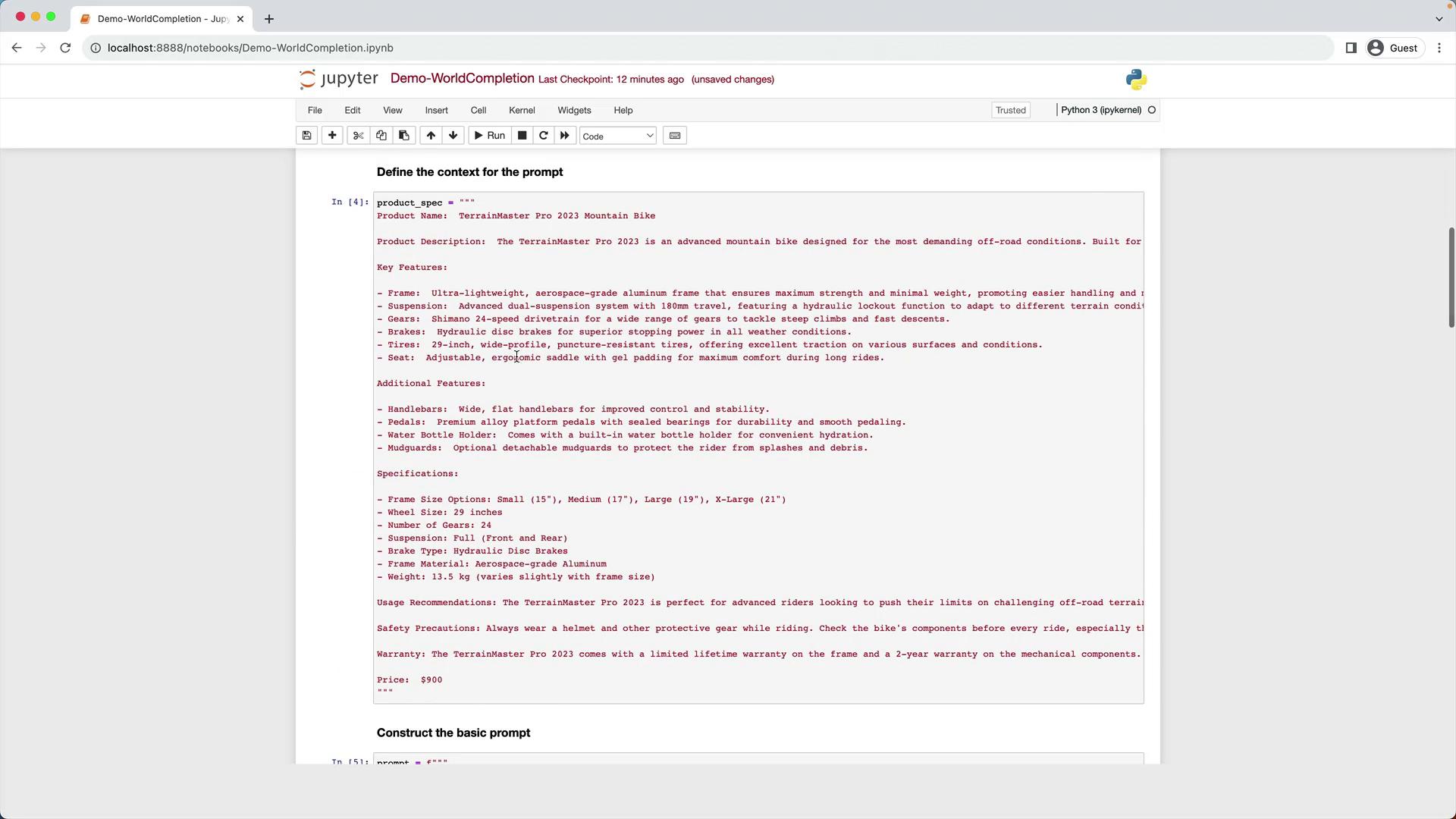Mastering Generative AI with OpenAI
Implementing Word Completion
Demo Implementing Word Completion
In this hands-on tutorial, you'll learn how to leverage the OpenAI ChatCompletion API inside a Jupyter Notebook to generate product descriptions, concise summaries, and HTML snippets. By the end, you'll have a reusable Python helper function and three prompt patterns for marketing automation.
Prerequisites
- Python 3.x
- openai Python package
- Jupyter Notebook
- An OpenAI API key
1. Setup: Import Modules & Configure API Key
Begin by importing the required libraries and setting your API key as an environment variable.
import os
import openai
# Securely load your API key; do NOT hardcode in notebooks shared publicly
openai.api_key = os.getenv("OPENAI_API_KEY")
# Uncomment the line below if you prefer to paste your key directly:
# openai.api_key = "<YOUR_API_KEY>"
Warning
Never commit your API key to source control. Use environment variables or a secrets manager to keep credentials safe.
2. Define the get_word_completion Helper Function
Encapsulate the ChatCompletion call in a function to simplify reuse:
def get_word_completion(prompt: str) -> str:
"""
Sends a list of messages to the ChatCompletion endpoint
and returns the assistant's content.
"""
messages = [
{"role": "system", "content": "You are a helpful assistant."},
{"role": "user", "content": prompt}
]
response = openai.ChatCompletion.create(
model="gpt-3.5-turbo",
messages=messages,
max_tokens=3000,
temperature=1.2,
n=1
)
return response.choices[0].message.content
ChatCompletion.create Parameters
| Parameter | Purpose | Example |
|---|---|---|
| model | Specifies which OpenAI model to use | gpt-3.5-turbo |
| messages | Conversation roles & content array | system + user |
| max_tokens | Max tokens in the generated response | 3000 |
| temperature | Controls randomness (0 = deterministic) | 1.2 |
| n | Number of completions to generate | 1 |
Note
Adjust temperature to control creativity; lower values yield more focused outputs, higher values produce varied text.
3. Prepare the Product Specification
We'll use a multi-line string as our product spec for a fictional TerrainMaster Pro 2023 Mountain Bike:
product_spec = """
Product Name: TerrainMaster Pro 2023 Mountain Bike
Product Description: The TerrainMaster Pro 2023 is an advanced mountain bike designed for the most demanding off-road conditions.
Key Features:
- Frame: Aerospace-grade aluminum frame for maximum strength and minimal weight.
- Suspension: Dual-suspension system with 180mm travel and hydraulic lockout.
- Gears: Shimano 24-speed drivetrain.
- Brakes: Hydraulic disc brakes.
- Tires: 29-inch, wide-profile, puncture-resistant tires.
- Seat: Ergonomic saddle with gel padding.
Additional Features:
- Handlebars: Wide, flat handlebars for improved control.
- Pedals: Alloy platform pedals with sealed bearings.
- Water Bottle Holder: Built-in for convenient hydration.
- Mudguards: Optional detachable mudguards.
Specifications:
- Frame Size: Small (15"), Medium (17"), Large (19"), X-Large (21").
- Wheel Size: 29 inches.
- Suspension: Full (front and rear).
- Brake Type: Hydraulic Disc.
- Frame Material: Aerospace-grade Aluminum.
- Weight: 13.5 kg (varies with frame size).
Usage Recommendations: Ideal for advanced riders on challenging off-road terrain.
Safety Precautions: Always wear protective gear and inspect components before riding.
Warranty: Limited lifetime frame warranty; 2-year warranty on other components.
Price: $900
"""
4. Example 1: Generating a Full Product Description
Use the full specification to generate a detailed website description.
prompt = f"""
Your task is to help the marketing team create a description
for a product website based on the product spec.
Write a description using the information provided
in the specifications delimited by triple backticks.
Technical specifications:
```{product_spec}```
"""
response = get_word_completion(prompt)
print(response)
```text
---
## 5. Example 2: Creating a Concise Version
To craft a shorter pitch for a landing page, simply instruct the model to be concise.
```python
prompt = f"""
Your task is to help the marketing team create a
description for a product website based on the product spec.
Write a concise description from the specifications
delimited by triple backticks.
Technical specifications:
```{product_spec}```
"""
response = get_word_completion(prompt)
print(response)
6. Example 3: Generating HTML with a Specifications Table
Ask GPT-3.5 Turbo to output a complete HTML snippet, including:
- An
<h1>with the product name - A
<div>styled in 12pt FireBrick font for the description - A titled table (
Product Specifications) with two columns: name & value - Table CSS: DarkSlateGray text, 100% width, 12pt font
prompt = f"""
Your task is to help the marketing team create
HTML for a product website based on the product spec.
- Add a <h1> header with the product name.
- Wrap the description in a <div> styled with font-size:12pt; color:FireBrick.
- Include a 'Product Specifications' table:
- Two columns: specification name | value
- Table style: color DarkSlateGray; width 100%; font-size 12pt
Product specifications:
```{product_spec}```
"""
response = get_word_completion(prompt)
print(response)
```text
---
## 7. Previewing HTML in Jupyter Notebook
Render the generated HTML inline using `IPython.display`:
```python
from IPython.display import display, HTML
display(HTML(response))

You’ve now implemented a flexible word completion demo! Next up, we’ll explore GPT-3.5 Turbo’s code-completion capabilities.
Watch Video
Watch video content
Practice Lab
Practice lab